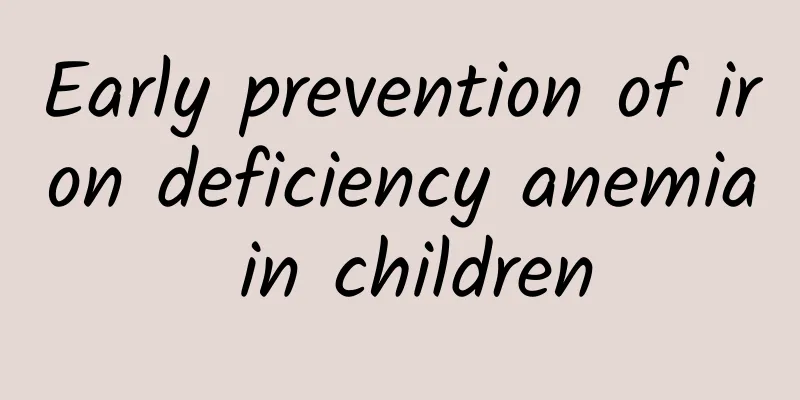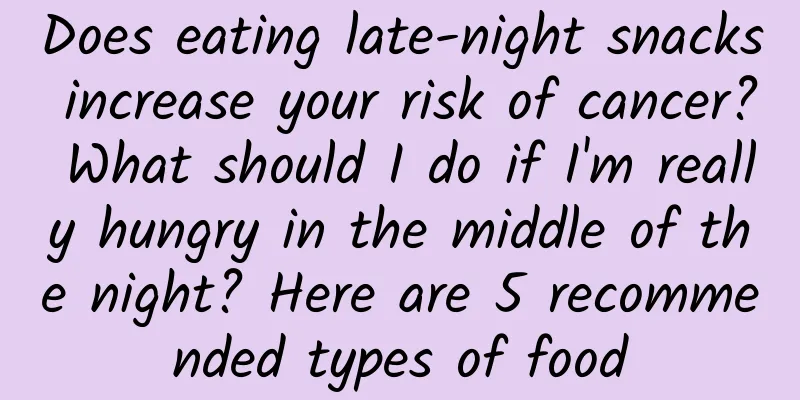Early prevention of iron deficiency anemia in children

|
Iron deficiency anemia is anemia caused by insufficient iron intake and absorption, increased iron demand, and excessive iron loss, which affects the synthesis of hemoglobin. It is characterized by microcytic hypochromic anemia, decreased serum ferritin, and effective iron therapy. The fetus obtains the most iron from the mother through the placenta in the third month of pregnancy, which can meet the needs of full-term infants within 4-5 months after birth, so premature infants are more prone to iron deficiency. The age of onset of iron deficiency anemia is between 6 months and 2 years old. Children are picky eaters and adolescents have more menstrual flow and grow faster, which increases the need for iron, which can also easily cause anemia. What are the causes of anemia? 1. Congenital iron deficiency The fetus obtains the most iron from the mother in the last three months of pregnancy, so premature birth, twins or multiple births, fetal blood loss and severe iron deficiency in the pregnant mother can all reduce the fetal iron storage and cause anemia. 2. Insufficient iron intake The iron content in human milk, cow's milk and cereals is low. If iron-rich complementary foods are not added in time, iron deficiency anemia is likely to occur. Picky eating and partial eating can also easily cause anemia. 3. Growth and development factors Infants grow and develop rapidly, and their iron needs increase. If iron-rich foods are not added in time, anemia can easily occur. 4. Impaired iron absorption Improper food combination can affect iron absorption. Plant fiber, milk, tea, coffee, antacids, etc. inhibit iron absorption, so they cannot be taken at the same time. Chronic diarrhea can cause poor iron absorption and increased iron excretion. 5. Excessive iron loss Chronic blood loss from the gastrointestinal tract and heavy menstruation in adolescent girls can both cause iron deficiency anemia. Symptoms of iron deficiency anemia Iron deficiency anemia develops slowly, and the early symptoms are not obvious. As the disease progresses, the following manifestations may appear: Pale skin and mucous membranes, fatigue, inactivity, dizziness, black spots in front of eyes; some children have gastrointestinal symptoms such as loss of appetite, pica (eating dirt, wall paint, etc.); in severe cases, there are nausea, vomiting, diarrhea, memory loss, lack of concentration, and reduced intelligence. Peripheral blood hemoglobin is divided into 4 degrees according to its severity: mild <90g/L, moderate 90-60g/L, severe 30-60g/L, and extremely severe <30g/L. Treatment 1. First of all, we need to strengthen care, ensure that the child gets enough sleep, avoid infection, and protect heart function in severe anemia. According to the child's digestive ability, appropriately increase iron-rich foods and pay attention to a reasonable diet. 2. Eliminate the cause: This is the key to treating anemia. Some anemias can be cured quickly after the cause is eliminated. 3. Iron supplement: Iron is a specific medicine for treating anemia, mainly taken orally. Vitamin C, dilute hydrochloric acid, fructose, amino acids, etc. can promote iron absorption; phosphoric acid, oxalic acid, etc. can form insoluble ferrites with iron, which are difficult to absorb; plant fiber, milk, tea, coffee, antacids, etc. inhibit the absorption of iron. Be careful not to take them at the same time. While undergoing iron treatment, the child's blood routine should be checked. Once the hemoglobin returns to normal, the iron supplement should be continued for 6-8 weeks to increase the child's iron stores. 4. Prevention is the key: do a good job of health education to make parents aware of the harm of iron deficiency to children and the importance of prevention. Breastfeeding is recommended because the absorption and utilization rate of iron in breast milk is high. Provide good feeding guidance. Whether it is breast-fed or bottle-fed infants, iron-rich and high-absorption iron complementary foods such as lean meat, black fungus, fish, etc. should be added to the child from the 4th month, and pay attention to the reasonable combination of meals. It is recommended that premature infants be given iron supplements for prevention from about 2 months. Adolescent girls should be given appropriate amounts of iron supplements for prevention during menstruation. Iron deficiency anemia has a good prognosis, but long-term untreated can lead to slow growth and development in children, decreased immunity, and in severe cases, it can affect intellectual development, so prevention is particularly important. |
>>: I can’t even move my hands. Can I still eat and wash myself?
Recommend
Vagina and urethra
"Are the vaginal opening and urethral openin...
What are the fetal movements at six months of pregnancy?
For pregnant mothers, the fetus in the belly grow...
Pregnancy Depression Test
Being a woman is hard, and being pregnant is even...
Can I get pregnant if my period is coming soon?
I believe that most female friends are familiar w...
What are the dangers of intrauterine adhesion amenorrhea?
Women may suffer from many kinds of gynecological...
These bad habits are quietly harming your stomach
Reference: Healthy China...
Authoritative research: This latest diet can extend your life by at least 10 years?
Written by: Zhu Hengheng Editor: Wang Haha Layout...
Is it painful to have an internal examination during childbirth?
Pregnancy is a happy thing, but during the entire...
Will I catch a cold during early pregnancy?
For normal people, colds, coughs and fevers are v...
Reasons for no embryo during pregnancy
Today's pregnant women are very young, so the...
What should I do if I have hemorrhoids?
Patients with hemorrhoids know that hemorrhoids a...
What are the causes of pelvic tuberculosis?
Tuberculosis mainly occurs after the endometrium ...
Can I use moxibustion after a caesarean section?
Because the delivery process is very painful, man...
Contractions every 5 minutes
Uterine contraction is a condition that mothers w...
What are the harms of prostatitis to women?
Prostatitis is likely to cause complications in w...

![[Look here] Do you have a cute kid with "double positive" or upper respiratory tract infection? To deal with "cough cough cough", we can do this 👇](/upload/images/67f1a621c4e67.webp)







